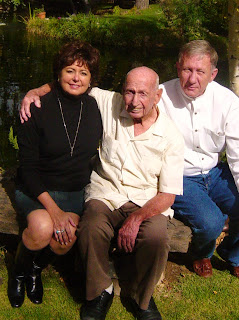 |
| Death at Nagasaki |
These days mark the anniversary of the atomic bombs being dropped on Japan, a prelude to the end of World War II 67 years ago. I was home snug in my crib when thousands of similar aged children were incinerated in Hiroshima, Aug. 6, 1945, and Nagasaki, Aug. 9, 1945.
I won't join the debate over dropping those bombs, killing a quarter million civilians within four months, and perhaps saving thousands of American lives from an invasion. That will go on a long time. Let is pray that it won't ever happen again.
But when I grew up in grade school through high school in Albuquerque, N.M., ten to 15 years later, the long shadows of those mushroom-shaped clouds hung over us. They still do..
We lived on Sandia Base, close to some of the scientific labs involved in nuclear activity, next to an airbase with Strategic Air Command bombers, and only 60 miles south of Los Alamos, where those bombs were perfected. Our enemy wasn't Japan, but the Soviet Union, which had stolen and developed its own atomic and hydrogen bobs, plus Intercontinental Ballistic Missiles (ICBMs), capable of hitting Albuquerque in about 30 minutes of launch time.
It affected our lives every day. Our parents had two cases of canned food stored under the kitchen sink in case we had to evaluate to the nearby mountains on the east of town. The entire base went through evaluation practice, driving to empty mesa land nearby to be escorted in an orderly manner to the supposed safety of the mountains. Albuquerque only had about 200,000 people then, but there was literally only one road to the mountains, old US 66 coming through Tijeras canyon. I thought even then that there was no way the entire town could get evaluated in 30 minutes. I'd seen photos of allied planes strafing jammed retreating Nazi armament in WWII along a single road in North Africa.
Then we were shown grainy black and white films of the bombs blowing away test structures and people. But still we practiced getting down under our Desks and covering our heads. That didn't make sense to me either, but we all did.
In junior high our textbooks were filled with information on how much better America and capitalism was than the USSR and communism. This followed the defection and brainwashing to Americans by communists in the Korean War in 1950, and the Communists of Mao Tse-tung defeating Chang Kai Shek who retreated to Formosa. It's the same time that McCarthyism in the latest "Red Scare" became a national witch hunt for supposed "Commies."
We knew we had reason to be afraid, because of Russia's isolation of Berlin, the split of Germany and Churchill's "Iron Curtain" speech. We'd seen what Russia did to protesters in Hungary in 1956, and their infiltration of African countries. Europe was divided, with tanks massed on both sides.
You cannot imagine the fear in 1959 when Russia launched the first satellite--we were all vulnerable.
The shadow of those bombs really accounts for use ending up in Vietnam to prevent the spread of communism, and our continuing isolation of Cuba, which fell to Castro in the early 60s. Kennedy and Johnson and then Nixon were following the national mindset of fear. I can remember high school debate where "detente" between the US and USSR was a controversial subject. With Russia getting ready to put missiles in Cuba, 90 miles south of us, what could we think. Khrushchev banging his shoe at the U.N., and threatening to bury us fit right in. The building of the Berlin Wall only cemented that fear through the '60s, and led to accusing hippies and war protesters as infiltrated by communists.
With the perspective of years, I react to much of the fear I see in America today after 911 against another enemy we don't understand. How else but fear do you recommend putting duct tape on your windows? That's as effective as getting under your desk or evacuating an entire city. Yet the long shadows of the bombs still linger, as we debate options of dealing with Iran and its nuclear development, and bandied fearful political name calling of "Socialist."
That's one perspective of growing up in the shadows of nuclear bombs.
 |
| Hiroshima |




























